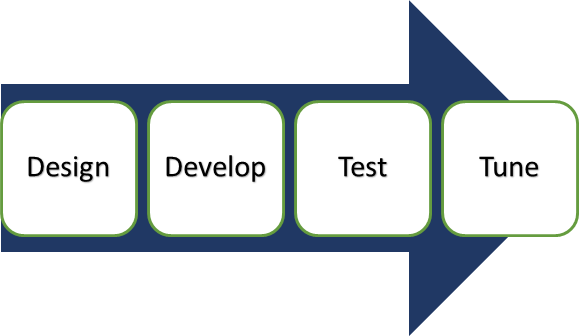1. Application testing?
Application testing is defined as a type of software testing, which is performed through scripts with a bug-finding engine in the software. It involves tests for the entire application.
Application testing helps improve your application quality while reducing costs, maximizing ROI and saving development time.
In Software Engineering, application testing can be performed in different categories such as GUI, function, database (backend), performance, etc.
For Application Testing, the test life cycle consists of various stages including requirements analysis, test planning, test analysis, test design, test execution & bug reporting, etc.
2. How to test the application
Applications and software products have a number of variations of the features they support and the processes they implement. Therefore, Application Testing ensures that a specific program or application works properly.
An application testing life cycle consists of four stages.
- Design test plan based on application requirements
- Develop test scripts: manual and automatic
- Perform application functionality tests to ensure the application runs correctly in the logic
- Perform load testing and adjust application performance

Application testing is classified into two segments.
- Test the web application
- Test desktop application
Test the web application
- Functional testing and performance testing
- Cross-browser testing
- Load test and stress
- Regression testing and compliance
- User acceptance test
- Beta Testing
- Exploration and exploration of smoke
- Multilingual support and compatibility testing
Test Desktop application
- User interface testing
- Usability test
- Productivity test
- Compatibility Test (Software / Hardware)
- Functional testing
- Security test
Mobile application testing
- User interface testing
- Test based on rules
- Regression test
- Functional testing
- Security test
3. Application testing method
Test methods are different ways to ensure that software applications are fully tested. Unorganized and poor testing methods can lead to an unstable product.
There are three ways testing is performed.
- Testing black box
- Test white box
- Gray box test
Testing black box
Black box testing techniques are commonly used for testing: Functional testing, Non-functional testing and Regression testing.
In black box testing, techniques are used
- Partitioning equivalent
- Marginal value analysis
- Decision table
- State transitions
Test white box
White box testing is often used to test software code to check for internal security vulnerabilities, broken or poorly structured paths, functions of conditional loops, etc.
In white box testing, the strategy used was
- Insurance code analysis
- Insurance path
Gray box test
This test technique is a combination of both black box testing as well as white box testing. It is made in accordance with regulations to find structural defects or use inappropriate applications.
4. Test plan for application testing
Test Plan documents are derived from product descriptions, SRS technical software requirements, or Case usage documents. The focus of testing is what needs testing, how to test, when to test and who will test. Test plan documents are used as a means of communication between the testing team and the test manager.
A standard test plan for Application Testing should identify the following features;
- Determine the scope of testing
- Determine test objectives
- Approach to testing activities
- Test schedule
- Bug tracking and reporting
5. Best practices for application testing
Choosing the right strategy for Application Testing is a guaranteed way to detect bugs in the application. Therefore, it is extremely important that the QA team follows a standard set of procedures to detect more errors and with less time.
To test the application, some best practices include:
- Define function parameters
- Evaluation and inspection
- Official entry and exit criteria
- Functional test variations
- Multi-platform testing
- Perform automated testing
6. The challenges of application testing
While testing the application, testers may face many challenges
- The problem is only identified when the user calls
- Inability to foresee the impact of change
- No visible application and operational errors
- Waste time
7. Test of mobile application
Like web application testing, mobile application testing is based on the same testing strategy and methodology. The difference may be in the tools used for testing, some of the common tools used for testing mobile applications are Sikuli, TestComplete, FoneMonkey, Robotium, etc.
Classification of mobile applications:
- Web application – It is accessed by users over a network like the internet or an intranet
- Original application – It was developed for a specific platform and installed on a computing device
- Hybrid application – It combines elements of both Web and native. For example: Facebook.
For most mobile platforms, you can use CSS, HTML, JS, etc.
8. Test cases for testing mobile applications
Complete mobile test application strategy including network and device infrastructure, target device selection and effective combination of manual and automated testing tools to cover non-functional testing and function.
For mobile apps, things to test are
Setting
- OTA
- WIFI
- Data cable
- Bluetooth
Uninstall
Application logo
Splash
Low memory
Visual feedback
Exit application
Start / Restart the application
9. Mobile challenge
With an increasing number of users and mobile devices, testing mobile applications is becoming more and more complex. Test a mobile application that is significantly different from a web based desktop application. The common challenges faced during mobile testing are
- Comprehensive test coverage
- Fragmentation management (different OS versions, processor, memory)
- Lack of testing plan
- Pressure of time
- Lack of physical equipment
- Diversity in platforms and operating systems
Conclusion
In Application Testing, the entire application is tested, for different approaches, tools and methods used. Running application tests before a live release is critical to the success of a software product.
